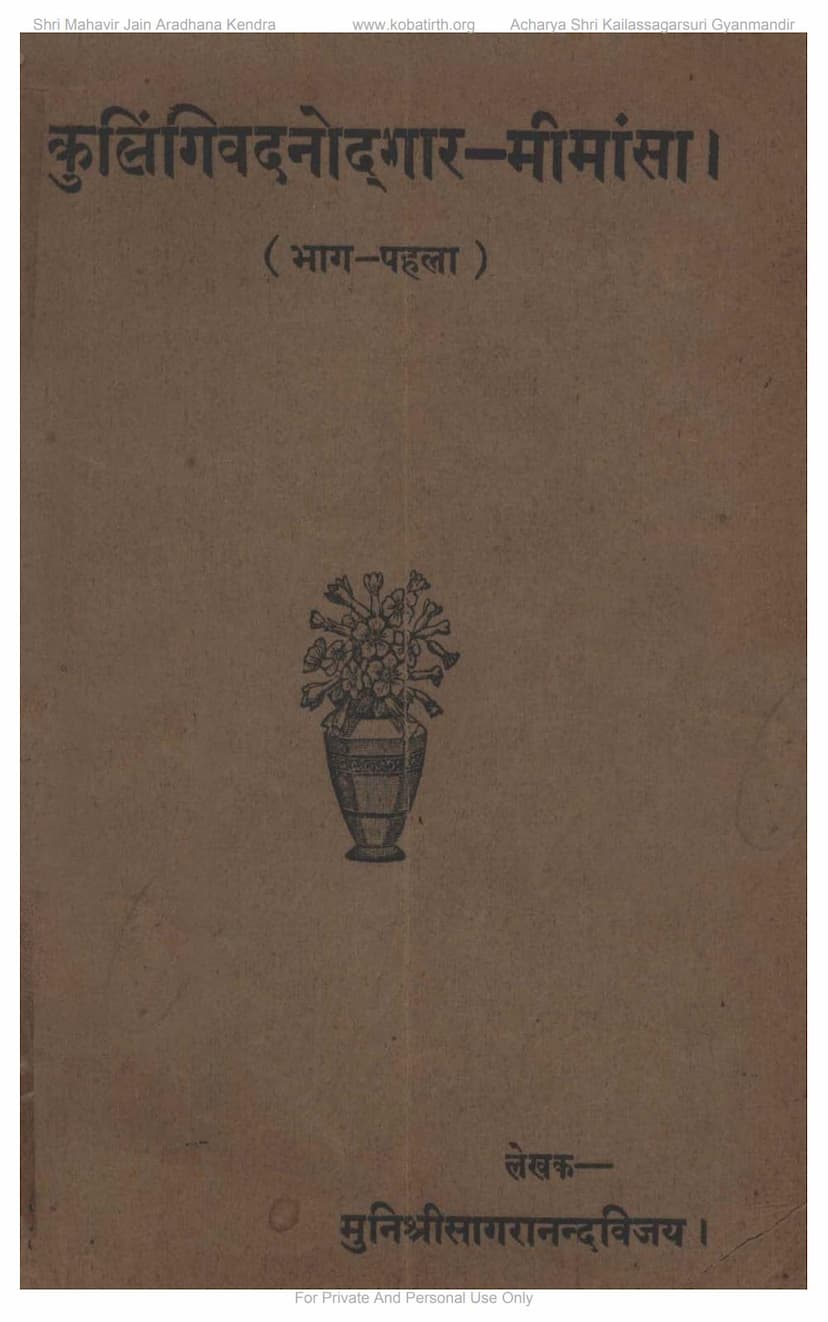Kulingivadanodgar Mimansa Part 01
Added to library: September 2, 2025

Summary
Here's a comprehensive summary of the provided Jain text, "Kulingivadanodgar Mimansa Part 01," based on the provided pages:
Book Title: Kulingivadanodgar Mimansa Part 01 Author: Muni Shri Sagaranandvijay Publisher: K. R Oswal, Javara (Malwa)
Overall Theme: This book is a polemical work, likely a response or critique of another text or viewpoint, as suggested by the title "Mimansa" (critical examination or exposition) and the content that immediately follows. It appears to be part of a larger debate or conflict within the Jain community, specifically concerning the practices and interpretations of Jain monks and nuns.
Key Focus Areas and Arguments:
-
A Challenge for a Scholarly Debate (Shastrarth): The initial pages (4-7) are dominated by a public challenge from Muni Yatindravijay (presumably the author or someone associated with him) to Muni Sagaranand Suriji. This challenge is presented as the fifth such invitation. The core of the debate revolves around a specific issue: whether Jain monks and nuns should wear white clothes according to the current teachings of Lord Mahavir, or if it is acceptable to change the practice (parivartan) due to the laxity or "apavada" (exceptions/looser interpretations) of some ascetics.
- The Challenge: Muni Yatindravijay states that previous challenges in Ratlam and Senbalia were evaded. He proposes specific, neutral locations (Bhandava-Mahavir and Bhiladiya Parshvanath in Jodhpur) for the debate, with a Jain non-believer as a mediator.
- The Stakes: Muni Yatindravijay pledges that if Sagaranand Suriji can prove, with Jain scriptures, that wearing white clothes is not good for monks and nuns in the current era, or that changing the dress code is permissible due to the laxity of ascetics, he will accept colored clothes. Otherwise, Sagaranand Suriji will have to wear white clothes in the presence of the assembly and the Tirthankar.
- Conditions: The challenge emphasizes the need for civilized discourse, with strict rules about who can speak and the loser bearing all expenses.
-
Critique of "Pita-Patagrah Mimansa" and "Yatindra Mukh Chapetika":
- "Pita-Patagrah Mimansa" (Yellow Cloth Attachment): The author refers to a previous work of his, "Pita-Patagrah Mimansa," which he describes as a miraculous text that reveals the truth to the learned and creates turmoil in the hearts of those who follow "Kulingi" (likely a derogatory term for those with lax interpretations or practices) and "Apavadi" (those who permit exceptions). He claims this book has proven its truth through debates and handbills.
- "Yatindra Mukh Chapetika": A significant portion of the book (pages 12-72) is dedicated to dissecting and refuting another text, "Yatindra Mukh Chapetika," whose author is unnamed, implying cowardice. The author of "Kulingivadanodgar Mimansa" claims this "Chapetika" is a slap to the face of those who call themselves "Yatindra" (leaders of ascetics), specifically targeting Sagaranand Suri.
-
Core Argument: The Purity of White Clothes in Jainism:
- The central argument throughout the book is that Jain scriptures and tradition mandate white clothes for monks and nuns. The author vehemently refutes any justification for wearing colored (yellow, saffron, etc.) clothes, especially as an "apavada" (exception) or due to the laxity of ascetics.
- Scriptural Interpretation: The author meticulously quotes and interprets various scriptures (e.g., Sutrakritanga, Acharaanga Sutra, Nishiha Sutra, Gachchachar Panyanna) to support his stance. He argues that while scriptures may permit washing clothes or using certain materials, the core principle for ascetics is to wear white, simple, and inexpensive garments.
- Rejection of "Apavada" for Colored Clothes: The author strongly criticizes the idea that the laxity or "apavada" of some individuals can justify a departure from the established norms of wearing white clothes. He labels such justifications as "kapol kalpit" (imaginary or fabricated).
- The Nature of "Jirn-praya": The author clarifies that "Jirn-praya" (worn-out or old) does not mean ragged or tattered, but rather simple, not ostentatious, and modest.
-
Critique of Opponents (Sagaranand Suri and "Pishach Panditacharya"):
- Character Assassination and Accusations: The author frequently uses derogatory terms like "Pishach Panditacharya" (demonic scholar-priest) and "Kulingi Apavadi" to describe his opponents. He accuses them of hypocrisy, greed, seeking worldly pleasures ("gadi-wadi-ladi ka prem"), misinterpreting scriptures, spreading falsehoods, and even abducting children.
- Evasion and Lack of Proof: The author repeatedly highlights how Sagaranand Suri and his associates have allegedly evaded scholarly debates and failed to provide scriptural evidence for their views on colored clothes.
- Misrepresentation of Scriptures: The author accuses his opponents of twisting the meanings of scriptures to suit their agenda. He provides detailed counter-interpretations of scriptural passages.
- Newspaper Evidence: The book extensively quotes newspaper articles (e.g., from "Jain Advocate," "Dainik Hindusthan," "Bombay Samachar") that allegedly expose the wrongdoings and hypocrisies of the opposing group, particularly concerning their alleged evasion of debates and their conduct.
-
Call for Purity and Adherence to Tradition:
- The book serves as a strong defense of the traditional Jain path, emphasizing the importance of adhering to the original teachings and practices, particularly regarding the attire of ascetics.
- The author encourages readers to critically examine the arguments and to reject those that lack scriptural backing and promote laxity.
Structure and Style:
- The book is highly argumentative and polemical.
- It extensively uses citations and interpretations of Jain scriptures.
- It includes a strong element of personal attack and critique against its perceived opponents.
- The author frequently refers to past debates and public challenges to establish his credibility and his opponents' alleged weaknesses.
In essence, "Kulingivadanodgar Mimansa Part 01" is a passionate defense of the tradition of white clothing for Jain ascetics, presented as the pure path prescribed by Lord Mahavir. It vehemently criticizes and challenges those who advocate for or permit the use of colored clothing, accusing them of misinterpreting scriptures, succumbing to worldly desires, and evading proper scriptural discourse.